Half a world, and half a lifetime away.
Discussion
yellowjack said:
Thanks. I get a lot of crap on some threads because I apparently "never shut up" about having been in the army.
Yes, I had noticed you seem to get a bit of flak (either about that, or because you have the audacity to cycle on the public highway  )
)I used to work for a company which has very close ties to the forces, a fair few co-workers were former Navy or RAF. Some saw action in Desert Storm, and in my early days at the company I'm sure there were some still there who would have served in the Falklands. Was always interesting to hear a few of their tales, good to get the human aspect.
Keep up your posts, I'm sure most people find them interesting (and if not then there's nothing forcing them to read it)

17th May
British peace proposals transmitted to Argentina.
The SAS team which parachuted into the sea is bundled into a Sea King HC4 from HMS Invincible and sent off to Argentina. It's going to be a one-way trip, the £4,000,000 helicopter will have just enough fuel to reach Chile after the SAS attacks Tierra del Fuego and lift off again. After it lands in Chile, the chopper will be destroyed, and the troops will turn themselves in.
Argentina's 'Navy Day', it was believed that there would be some major offensive actions.
Invincible's first CAP of the day dropped a couple of 1,000lb bombs on the Port Stanley airfield.
800 Squadron made a photo reconnaissance trip, bringing back pictures of Fox Bay, Goose Green, Port King and settlements in Lafonia.
The Sea Harriers provided defensive CAP for the Battle Group throughout the day in anticipation of any air attacks.
The Argentine Navy launched a Super Etendard attack but without the Neptune's shadowing capabilities, they had not been able to maintain their plot of the Battle Group's movements. This and deception measures put in place by the senior aviators on the British carriers meant that when the pair of Super Etendards popped up to target their Exocets, their radars swept only empty sea.
Helicopters were moved in order to prepare for the arrival of Atlantic Conveyor and her cargo.
HMS Hermes left the group in the mid-afternoon in order to rendezvous outside the TEZ with Atlantic Conveyor.
One of Hermes' Sea King 5s was lost in the evening, the aircraft had to be ditched due to instrument malfunction.
Argentine Air Force commander Brigadier Lami Dozo warned that British task force will receive 'massive attack' if it sails within range of Argentine weapons.
EEC renewed sanctions against Argentina for another week: Italy and Ireland lift them altogether.
SD.
British peace proposals transmitted to Argentina.
The SAS team which parachuted into the sea is bundled into a Sea King HC4 from HMS Invincible and sent off to Argentina. It's going to be a one-way trip, the £4,000,000 helicopter will have just enough fuel to reach Chile after the SAS attacks Tierra del Fuego and lift off again. After it lands in Chile, the chopper will be destroyed, and the troops will turn themselves in.
Argentina's 'Navy Day', it was believed that there would be some major offensive actions.
Invincible's first CAP of the day dropped a couple of 1,000lb bombs on the Port Stanley airfield.
800 Squadron made a photo reconnaissance trip, bringing back pictures of Fox Bay, Goose Green, Port King and settlements in Lafonia.
The Sea Harriers provided defensive CAP for the Battle Group throughout the day in anticipation of any air attacks.
The Argentine Navy launched a Super Etendard attack but without the Neptune's shadowing capabilities, they had not been able to maintain their plot of the Battle Group's movements. This and deception measures put in place by the senior aviators on the British carriers meant that when the pair of Super Etendards popped up to target their Exocets, their radars swept only empty sea.
Helicopters were moved in order to prepare for the arrival of Atlantic Conveyor and her cargo.
HMS Hermes left the group in the mid-afternoon in order to rendezvous outside the TEZ with Atlantic Conveyor.
One of Hermes' Sea King 5s was lost in the evening, the aircraft had to be ditched due to instrument malfunction.
Argentine Air Force commander Brigadier Lami Dozo warned that British task force will receive 'massive attack' if it sails within range of Argentine weapons.
EEC renewed sanctions against Argentina for another week: Italy and Ireland lift them altogether.
SD.
shed driver said:
deception measures put in place by the senior aviators on the British carriers meant that when the pair of Super Etendards popped up to target their Exocets, their radars swept only empty sea.
To expand on this (and if I recall correctly) one deception method was for the CAP aircraft to launch and fly at low level. After flying for some distance (100 miles is the figure that pops up in my head, but that could be too far) they would pop-up to normal height. Trying to fool the Argentinians into thinking that they where 100 miles further west than they actually where. 18th May
HMS Invicible's first three CAP missions drops six 1,000lb bombs on Port Stanley airfield.
Four Sea Harriers and four RAF Harriers take off from the Atlantic Conveyor to HMS Hermes.
The STUFT Europic Ferry was following with the Amphibious Group carrying RN Wessex and RAF Chinook helicopters and ground crews. Once the Amphibious Group met with the Carrier Battle Group the jets would be off the Atlantic Conveyor allowing the helicopters to be transferred for preparation.
The Carrier Battle Group and Amphibious Group rendezvous in the evening and although the Argentine Air Force miss this, they are soon provided with the information by the BBC World Service.
Hopes fade for a successful outcome to United Nations peace negotiations.
Thatcher makes statement to the Commons regarding the Falklands Situation and the status of the Peruvian Peace Plan.
SD.
HMS Invicible's first three CAP missions drops six 1,000lb bombs on Port Stanley airfield.
Four Sea Harriers and four RAF Harriers take off from the Atlantic Conveyor to HMS Hermes.
The STUFT Europic Ferry was following with the Amphibious Group carrying RN Wessex and RAF Chinook helicopters and ground crews. Once the Amphibious Group met with the Carrier Battle Group the jets would be off the Atlantic Conveyor allowing the helicopters to be transferred for preparation.
The Carrier Battle Group and Amphibious Group rendezvous in the evening and although the Argentine Air Force miss this, they are soon provided with the information by the BBC World Service.
Hopes fade for a successful outcome to United Nations peace negotiations.
Thatcher makes statement to the Commons regarding the Falklands Situation and the status of the Peruvian Peace Plan.
SD.
shed driver said:
18th May
The STUFT Europic Ferry was following with the Amphibious Group carrying RN Wessex and RAF Chinook helicopters and ground crews.
My uncle worked for Townsend Thoresen and he will be pleased that Europic Ferry has been mentioned.The STUFT Europic Ferry was following with the Amphibious Group carrying RN Wessex and RAF Chinook helicopters and ground crews.
I hope it is OK to post this picture

There are more STUFT (Ship Taken Up From Trade) here http://www.rfanostalgia.org/gallery3/index.php/RFA... and also http://www.rfanostalgia.org/gallery3/index.php/rss...
Edited by Actual on Thursday 18th May 08:56
shed driver said:
The Carrier Battle Group and Amphibious Group rendezvous in the evening and although the Argentine Air Force miss this, they are soon provided with the information by the BBC World Service.
Firstly SD, and everyone else that has contributed, a big thanks from me - it's one of the most interesting threads I've read on PH. I remember watching it develop on the News - I was 13 at the time, but this thread really gives a good account of what went on (and has caused me to learn much more about it via other websites, youtube documentaries etc.).Regarding the above quote, and also the one where the BBC helpfully informed the Argentinians about the detonator issue with their bombs that weren't exploding - really? WTF were they doing??? Was there no censorship or control over what they broadcast? And even if not, how stupid could they be to broadcast this stuff knowing the Argentinians would pick it up?
ETA - Surely if anything, the BBC could/should have been used to deliberately mislead/misinform the Argentinians with false reports?
Were any lessons learned from this and later applied to the Gulf and Afghanistan?
Edited by C&C on Thursday 18th May 14:27
[quote=C&C]
Firstly SD, and everyone else that has contributed, a big thanks from me - it's one of the most interesting threads I've read on PH. I remember watching it develop on the News - I was 13 at the time, but this thread really gives a good account of what went on (and has caused me to learn much more about it via other websites, youtube documentaries etc.).
Regarding the above quote, and also the one where the BBC helpfully informed the Argentinians about the detonator issue with their bombs that weren't exploding - really? WTF were they doing??? Was there no censorship or control over what they broadcast? And even if not, how stupid could they be to broadcast this stuff knowing the Argentinians would pick it up?
ETA - Surely if anything, the BBC could/should have been used to deliberately mislead/misinform the Argentinians with false reports?
Were any lessons learned from this and later applied to the Gulf and Afghanistan?
[/quote]
The BBC has rules about impartiality - Thatcher criticised the BBC for referring to "British Forces" rather than "our boys" in her diaries. The BBC World Service was funded by the Foreign and Commonwealth Office rather than the licence fee, which did cause some friction. There are many examples of the BBC reporting that may have helped the Argentinean effort (or hindered the British). As far as I'm aware there was no strict censorship of reporting and no D-notices issued - it was all editorial judgement.
The attack on Goose Green was an example of where information was given which could have given an advantage to the Argentinian defenders but in the end it turns out that they refused to believe the reports and thought they were a diversionary tactic. (I will cover this later on the appropriate date).
Interestingly, many servicemen hold a deep resentment for the BBC from this time.
Maybe censorship in the age of 24 hour rolling news and instantaneous communications is the subject for another thread?
SD.
Firstly SD, and everyone else that has contributed, a big thanks from me - it's one of the most interesting threads I've read on PH. I remember watching it develop on the News - I was 13 at the time, but this thread really gives a good account of what went on (and has caused me to learn much more about it via other websites, youtube documentaries etc.).
Regarding the above quote, and also the one where the BBC helpfully informed the Argentinians about the detonator issue with their bombs that weren't exploding - really? WTF were they doing??? Was there no censorship or control over what they broadcast? And even if not, how stupid could they be to broadcast this stuff knowing the Argentinians would pick it up?
ETA - Surely if anything, the BBC could/should have been used to deliberately mislead/misinform the Argentinians with false reports?
Were any lessons learned from this and later applied to the Gulf and Afghanistan?
Edited by C&C on Thursday 18th May 14:27
[/quote]
The BBC has rules about impartiality - Thatcher criticised the BBC for referring to "British Forces" rather than "our boys" in her diaries. The BBC World Service was funded by the Foreign and Commonwealth Office rather than the licence fee, which did cause some friction. There are many examples of the BBC reporting that may have helped the Argentinean effort (or hindered the British). As far as I'm aware there was no strict censorship of reporting and no D-notices issued - it was all editorial judgement.
The attack on Goose Green was an example of where information was given which could have given an advantage to the Argentinian defenders but in the end it turns out that they refused to believe the reports and thought they were a diversionary tactic. (I will cover this later on the appropriate date).
Interestingly, many servicemen hold a deep resentment for the BBC from this time.
Maybe censorship in the age of 24 hour rolling news and instantaneous communications is the subject for another thread?
SD.
Adam B said:
shed driver said:
HMS Invicible's first three CAP missions drops six 1,000lb bombs on Port Stanley airfield.
this is now quite a tally of large bombs dropped on the airfield - is it now a muddy field or do we keep missing?http://www.thinkdefence.co.uk/operation-black-buck...
This details the damage done (around 1000 "scabs" in the concrete repaired post-war):
http://www.thinkdefence.co.uk/operation-black-buck...
19th May
Cabinet gives approval for landings.
HMS Glamorgan spends the night of the 18/19 bombarding targets between Port Stanley and Lively Island.
HMS Brilliant and Alacrity patrol to the north of Falkland Sound.
A stream of warships, RFAs and STUFTs are still heading south from Ascension. Surveillance support is provided by a Nimrod 2P flown from Ascension.
The Battle and Amphibious Groups spend the day east-north-east of Port Stanley moving aircraft, weapons, equipment and assault units.
Realising that perhaps it would not be the best idea to sail into the assault with the entire 3,000 man brigade sitting on one cruise liner, the day is spent cross-decking troops so that not all the eggs were in one basket. By a stroke of excellent fortune, the seas were calm, allowing the small landing craft to shuttle troops around. Some 2000 soldiers are cross-decked before the weather kicks up again.
A Sea King HC.4 with thirty men aboard ditches into the sea, probably due to mechanical failure. It is surmised that a bird strike with an albatross caused the crash as feathers were found floating near the crash point. Twenty-two were lost, of whom twenty were SAS. Many of them were survivors of the South Georgia op. The pilot, Flt Lt G. W. Hawkins was the only RAF fatality of the conflict.
HMS Invincible remained in the TEZ to cover the activity. The last of 809 Squadron's Sea Harriers are flown onto her from the Atlantic Conveyor later in the day.
An additional four Harrier GR3s arrive, flown in one long hop from the UK, with multiple mid-air refuellings. The first time the pilots had ever tried landing on a carrier was in the South Atlantic.
SD.
Cabinet gives approval for landings.
HMS Glamorgan spends the night of the 18/19 bombarding targets between Port Stanley and Lively Island.
HMS Brilliant and Alacrity patrol to the north of Falkland Sound.
A stream of warships, RFAs and STUFTs are still heading south from Ascension. Surveillance support is provided by a Nimrod 2P flown from Ascension.
The Battle and Amphibious Groups spend the day east-north-east of Port Stanley moving aircraft, weapons, equipment and assault units.
Realising that perhaps it would not be the best idea to sail into the assault with the entire 3,000 man brigade sitting on one cruise liner, the day is spent cross-decking troops so that not all the eggs were in one basket. By a stroke of excellent fortune, the seas were calm, allowing the small landing craft to shuttle troops around. Some 2000 soldiers are cross-decked before the weather kicks up again.
A Sea King HC.4 with thirty men aboard ditches into the sea, probably due to mechanical failure. It is surmised that a bird strike with an albatross caused the crash as feathers were found floating near the crash point. Twenty-two were lost, of whom twenty were SAS. Many of them were survivors of the South Georgia op. The pilot, Flt Lt G. W. Hawkins was the only RAF fatality of the conflict.
HMS Invincible remained in the TEZ to cover the activity. The last of 809 Squadron's Sea Harriers are flown onto her from the Atlantic Conveyor later in the day.
An additional four Harrier GR3s arrive, flown in one long hop from the UK, with multiple mid-air refuellings. The first time the pilots had ever tried landing on a carrier was in the South Atlantic.
SD.
20th May
Royal Navy Sea King helicopter from HMS Invincible crashed on a beach near Punta Arenas in Chile. The crew of three burn their machine and go into hiding, later surrendering and being repatriated.
The first offensive mission flown by the RAF from an aircraft carrier since October 1918, was launched from HMS Hermes.
Secretary Perez de Cuellar admits the failure of UN peace talks.
Thatcher accuses Argentina of 'obduracy and delay, deception and bad faith', tells Commons of collapse of peace process and orders task force into battle.
RMS St. Helena requisitioned by the Task Force - 19 Saint Helenian sailors volunteer to serve aboard alongside naval personnel, and after the end of the War she stays in the Islands as a minesweeper.
14:15. The Task Force splits up.
HMSGlamorgan is sent to Choiseul Sound, on the East Side of East Falkland, with orders to do its best at playing a one-ship amphibious night assault, with prodigous expenditure of 4.5" HE and starshells.
The Task Force Carrier Group, consisting of the two carriers, the destroyers [i/]Glamorgan, Glasgow[/i] (Repaired for now, but it would soon return to the UK), Coventry, the frigates Arrow and Alacrity, and the supply ships Olmeda, Resource, Regent, Tidepool, Pearleaf, Elk, Fort Toronto and Atlantic Conveyor. Its job was to try to run interference for the amphibious group.
The Amphibious Group, upon which the British hopes rested consisted of:
HMS Fearless and sister ship Intrepid (Rear) Purpose-built assault ships, carrying troops and with a well deck, and carrying eight landing craft each.

RFAs Sir Galahad, Sir Tristram, Sir Geraint, Sir Lancelot, Sir Percivale.
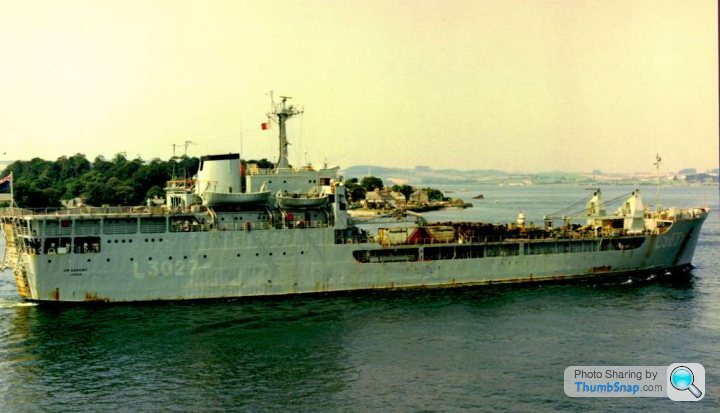
RFA Sir Geraint pictured
SS Norland, a car ferry.
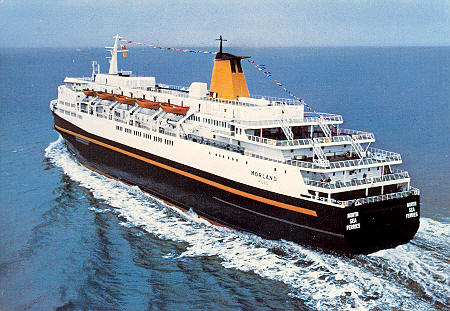
SS Norland in peacetime
SS Europic Ferry.
RFA Stromness. (later USNS Saturn)
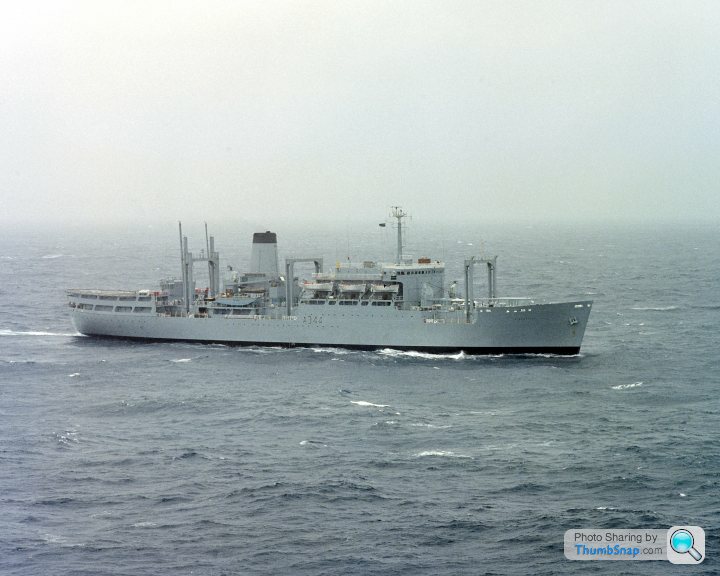
RFA Stromness
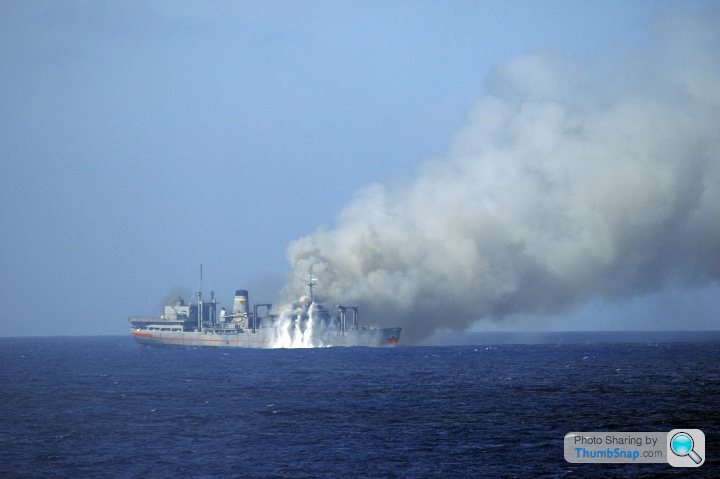
USNS Saturn (ex RFA Stromness) seen here in a SINKEX taking 20mm rounds from Phalanx on board USS Mitscher
SS Canberra, AKA The Great White Whale.
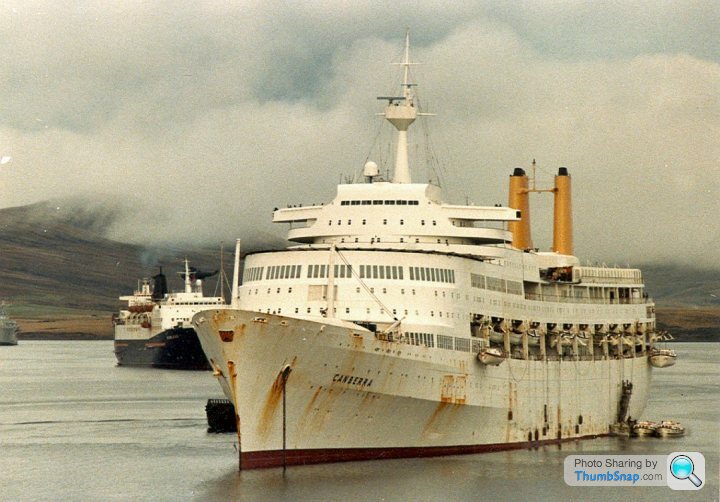
SS Canberra with the iconic Falklands rust paint scheme!
RFA Fort Austin, with a full load of helicopters.
Protecting them in what was soon to be called "Bomb Alley" were seven warships.
County Class destroyer HMS Antrim, sister ship to HMS Glamorgan. An old destroyer, with twin guns, and a rudimentary air defence system consisting of old Sea Slug missiles, and TV-Guided Sea Cats.
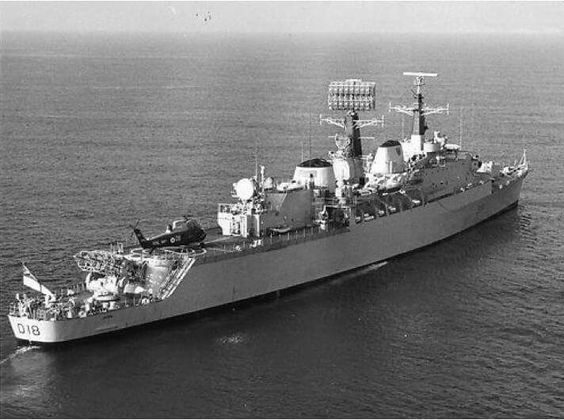
HMS Antrim
HMS Plymouth, and sister ship HMS Yarmouth. Veteran (read: old!) Type 12 anti-submarine frigate with Sea Cats and the twin guns.
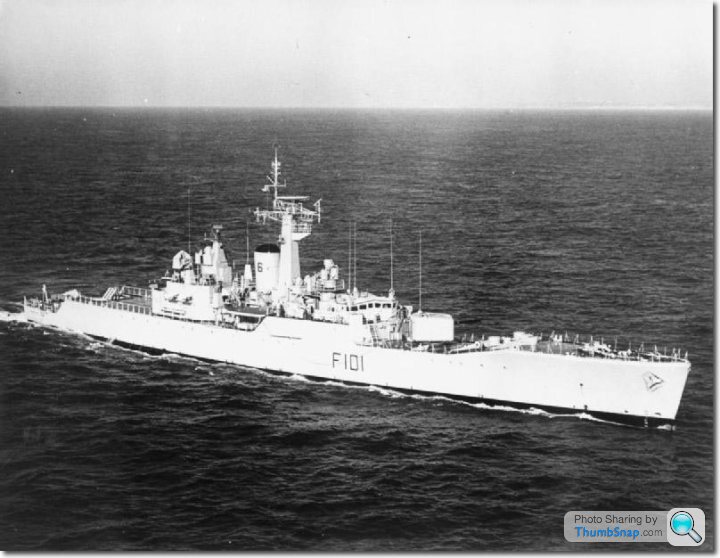
HMS Yarmouth
HMS Argonaut. Classic 'Leander' class frigate, upgraded to Exocet Leander standard. This replaced the twin gun mount with anti-ship missiles, reducing her effectiveness to 40mm cannons and Sea Cats.
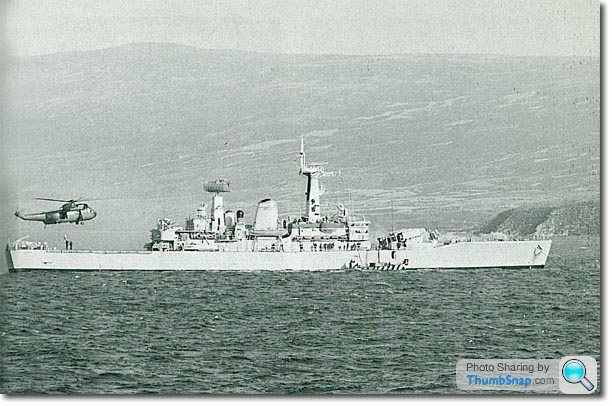
HMS Argonaut
Type 21 Anti-submarine frigate HMS Ardent. More modern Mk8 gun, and Sea Cats.

HMS Ardent
HMS Brilliant, and Broadsword. Armed with the Sea Wolf missile system, so new that one of the sailed with a Marconi rep aboard conducting after-sales support who was shanghaid for the war. Short ranged system, but well regarded.

HMS Broadsword
That was it, the entire fleet and its defences, covered by about 30 Harriers, and a little over 3,000 men assaulting enemy-held islands with over 10,000 troops and some 150 aircraft.
SD.
Royal Navy Sea King helicopter from HMS Invincible crashed on a beach near Punta Arenas in Chile. The crew of three burn their machine and go into hiding, later surrendering and being repatriated.
The first offensive mission flown by the RAF from an aircraft carrier since October 1918, was launched from HMS Hermes.
Secretary Perez de Cuellar admits the failure of UN peace talks.
Thatcher accuses Argentina of 'obduracy and delay, deception and bad faith', tells Commons of collapse of peace process and orders task force into battle.
RMS St. Helena requisitioned by the Task Force - 19 Saint Helenian sailors volunteer to serve aboard alongside naval personnel, and after the end of the War she stays in the Islands as a minesweeper.
14:15. The Task Force splits up.
HMSGlamorgan is sent to Choiseul Sound, on the East Side of East Falkland, with orders to do its best at playing a one-ship amphibious night assault, with prodigous expenditure of 4.5" HE and starshells.
The Task Force Carrier Group, consisting of the two carriers, the destroyers [i/]Glamorgan, Glasgow[/i] (Repaired for now, but it would soon return to the UK), Coventry, the frigates Arrow and Alacrity, and the supply ships Olmeda, Resource, Regent, Tidepool, Pearleaf, Elk, Fort Toronto and Atlantic Conveyor. Its job was to try to run interference for the amphibious group.
The Amphibious Group, upon which the British hopes rested consisted of:
HMS Fearless and sister ship Intrepid (Rear) Purpose-built assault ships, carrying troops and with a well deck, and carrying eight landing craft each.

RFAs Sir Galahad, Sir Tristram, Sir Geraint, Sir Lancelot, Sir Percivale.

RFA Sir Geraint pictured
SS Norland, a car ferry.

SS Norland in peacetime
SS Europic Ferry.
RFA Stromness. (later USNS Saturn)

RFA Stromness

USNS Saturn (ex RFA Stromness) seen here in a SINKEX taking 20mm rounds from Phalanx on board USS Mitscher
SS Canberra, AKA The Great White Whale.

SS Canberra with the iconic Falklands rust paint scheme!
RFA Fort Austin, with a full load of helicopters.
Protecting them in what was soon to be called "Bomb Alley" were seven warships.
County Class destroyer HMS Antrim, sister ship to HMS Glamorgan. An old destroyer, with twin guns, and a rudimentary air defence system consisting of old Sea Slug missiles, and TV-Guided Sea Cats.

HMS Antrim
HMS Plymouth, and sister ship HMS Yarmouth. Veteran (read: old!) Type 12 anti-submarine frigate with Sea Cats and the twin guns.

HMS Yarmouth
HMS Argonaut. Classic 'Leander' class frigate, upgraded to Exocet Leander standard. This replaced the twin gun mount with anti-ship missiles, reducing her effectiveness to 40mm cannons and Sea Cats.

HMS Argonaut
Type 21 Anti-submarine frigate HMS Ardent. More modern Mk8 gun, and Sea Cats.

HMS Ardent
HMS Brilliant, and Broadsword. Armed with the Sea Wolf missile system, so new that one of the sailed with a Marconi rep aboard conducting after-sales support who was shanghaid for the war. Short ranged system, but well regarded.

HMS Broadsword
That was it, the entire fleet and its defences, covered by about 30 Harriers, and a little over 3,000 men assaulting enemy-held islands with over 10,000 troops and some 150 aircraft.
SD.
21st May
All times LOCAL, not ZULU
HMS Ardent enters Falkland Sound. SBS teams are ferried by helicopter to prepare to assault a garrison position on Fanning Head.
01:30. HMS Antrim follows in.
01:45. HMS Fearless, followed by Intrepid enter the sound, by 02:30 they had made the turn to port entering San Carlos Water. The ships wells are flooded, and the landing craft prepared.
02:30. HMS Plymouth escorts Canberra, Stromness, Norland and Fort Austin into the sound, with Brilliant bringing up the rear.
03:50 HMS Antrim announces the British presence in San Carlos by commencing a bombardment of the Fanning Head position with its twin guns. After over 250 rounds were fired, the SBS teams charged in, finding 21 dead or wounded, the survivors had fled.
0600. The five 'Sirs' escorted by Argonaut and Broadsword enter.
07:30. First landing craft beach on San Carlos's water edge. 2 Para just beat 40 Commando to land, but the latter ran up the first flag, in San Carlos Settlement.
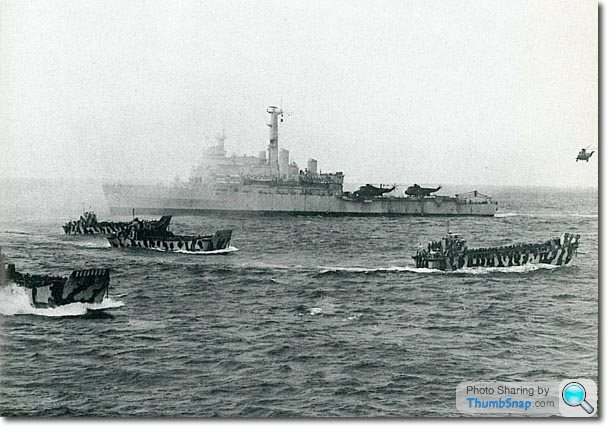
Daybreak. An Argentine Army lieutenant looks out over towards San Carlos from his position, and calls his headquarters to report that he was watching two British ships unloading troops. The Staff were disbelieving, as a pre-war study had determined San Carlos to be unsuitable for a successful landing.
Harriers patrolling to the East discover a hidden helicopter base near Mount Kent, and destroy two Pumas and a Chinook on the ground. 45 minutes later, a Harrier GR3 flown by Flt Lt Jeremy Glover was shot down by ground fire near Port Howard.
Back at San Carlos, two Gazelle scout helicopters are shot down by the Argentinians who had run away from Fanning Head. This was an early indicator that the Gazelle was perhaps not as battleworthy helicopter as hoped.
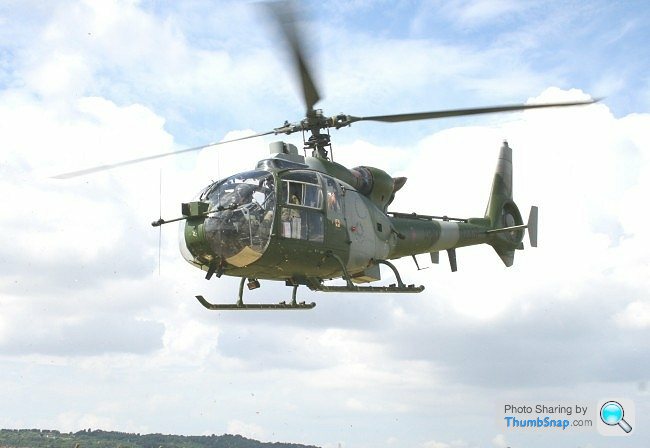
10:00 The Argentine Navy, which had intercepted the Army Lieutenant's signal decides to send a single aircraft over to San Carlos just in case. As he flew West, he saw a British helicopter, and swung over to attack it. As he crossed the final ridge he saw "the entire British fleet," and being a rather game sort, decided to attack it, and picked RFA Fort Austin. All the bombs missed, and the Aermacchi escaped to tell of what he saw arrayed in Falkland Sound.
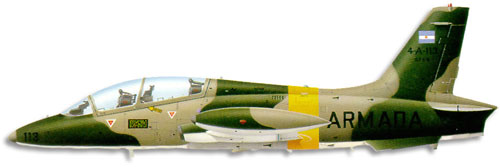
More to come later - I'm working earlies tomorrow.
SD.
All times LOCAL, not ZULU
HMS Ardent enters Falkland Sound. SBS teams are ferried by helicopter to prepare to assault a garrison position on Fanning Head.
01:30. HMS Antrim follows in.
01:45. HMS Fearless, followed by Intrepid enter the sound, by 02:30 they had made the turn to port entering San Carlos Water. The ships wells are flooded, and the landing craft prepared.
02:30. HMS Plymouth escorts Canberra, Stromness, Norland and Fort Austin into the sound, with Brilliant bringing up the rear.
03:50 HMS Antrim announces the British presence in San Carlos by commencing a bombardment of the Fanning Head position with its twin guns. After over 250 rounds were fired, the SBS teams charged in, finding 21 dead or wounded, the survivors had fled.
0600. The five 'Sirs' escorted by Argonaut and Broadsword enter.
07:30. First landing craft beach on San Carlos's water edge. 2 Para just beat 40 Commando to land, but the latter ran up the first flag, in San Carlos Settlement.

Daybreak. An Argentine Army lieutenant looks out over towards San Carlos from his position, and calls his headquarters to report that he was watching two British ships unloading troops. The Staff were disbelieving, as a pre-war study had determined San Carlos to be unsuitable for a successful landing.
Harriers patrolling to the East discover a hidden helicopter base near Mount Kent, and destroy two Pumas and a Chinook on the ground. 45 minutes later, a Harrier GR3 flown by Flt Lt Jeremy Glover was shot down by ground fire near Port Howard.
Back at San Carlos, two Gazelle scout helicopters are shot down by the Argentinians who had run away from Fanning Head. This was an early indicator that the Gazelle was perhaps not as battleworthy helicopter as hoped.

10:00 The Argentine Navy, which had intercepted the Army Lieutenant's signal decides to send a single aircraft over to San Carlos just in case. As he flew West, he saw a British helicopter, and swung over to attack it. As he crossed the final ridge he saw "the entire British fleet," and being a rather game sort, decided to attack it, and picked RFA Fort Austin. All the bombs missed, and the Aermacchi escaped to tell of what he saw arrayed in Falkland Sound.

More to come later - I'm working earlies tomorrow.
SD.
shed driver said:
19th May
An additional four Harrier GR3s arrive, flown in one long hop from the UK, with multiple mid-air refuellings. The first time the pilots had ever tried landing on a carrier was in the South Atlantic.
That's as impressive as Black Buck in it's way. Covering that distance over water in a cramped single engine aircraft noted for being tricky to fly, and then doing their first ever carrier landing at the end of it. Some of the pilots might not even have seen an aircraft carrier in the flesh before.An additional four Harrier GR3s arrive, flown in one long hop from the UK, with multiple mid-air refuellings. The first time the pilots had ever tried landing on a carrier was in the South Atlantic.
Do Harriers even have autopilots?
21st May Supplemental.
Two Pucara attack aircraft showed up about five minutes later. One was shot down by a hand-held Stinger missile from the SBS team on Fanning Head, the other was downed by a Sea Cat missile from a ship.

Shortly afterwards, a second Aermacchi turned up, and attacked HMS Argonaut with rockets and gunfire. Three sailors were injured, two seriously, and the big Type 965 radar suffered a large hole. The Aermacchi escaped through two missiles and a barrage of gunfire.
12:35 A formation of three Daggers arrives. Argonaut, Intrepid and Plymouth fire Sea Cats, Plymouth blows one Dagger up.
The second Dagger aims for HMS Broadsword, hitting with 29 30mm shells, but missing with both bombs. Fourteen sailors injured, and both helicopters damaged.
The third Dagger went for Antrim. A thousand-pounder struck the ship, went through the flight deck, bouncing off two big Sea Slug missiles in the magazine, and came to rest in the Head, starting a couple of fires. All the missile systems were knocked out.
12:41. Three more Daggers show up, and make for Antrim, whose crew are jettisoning missiles over the side in case the fires reached them. One got jettisonned by being fired in the general direction of the daggers, albeit unguided. Antrim was reduced to the twin guns in anti-air mode. One Dagger strafed with cannon, injuring seven more sailors and causing more fires. Second Dagger diverted to Fort Austin before being shot down by a Sea Wolf from Broadsword.
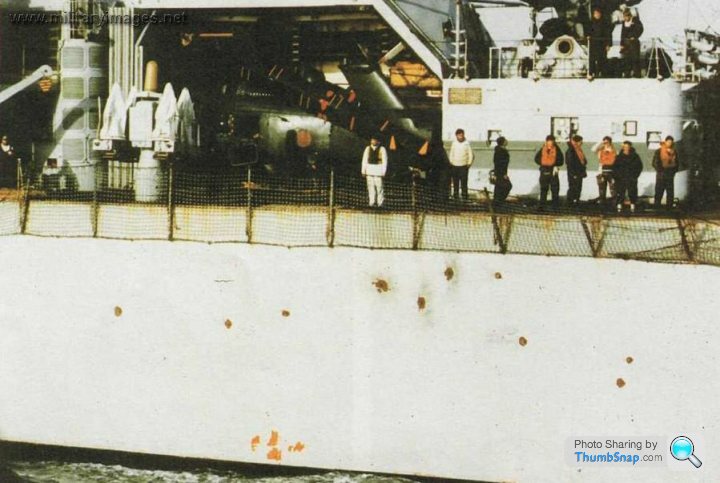
Bullet holes seen on HMS Antrim
The third Dagger now aimed for Broadsword, strafing her, but missing with the bomb.
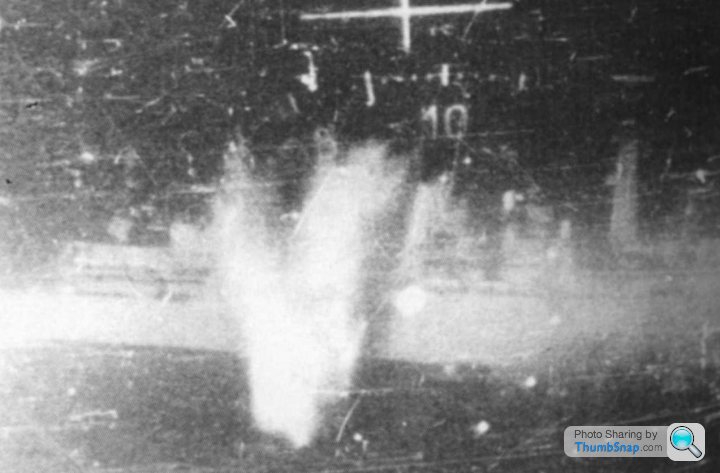
Gun sight image from Argentinean Dagger during strafing run on HMS {i]broadsword[/i]
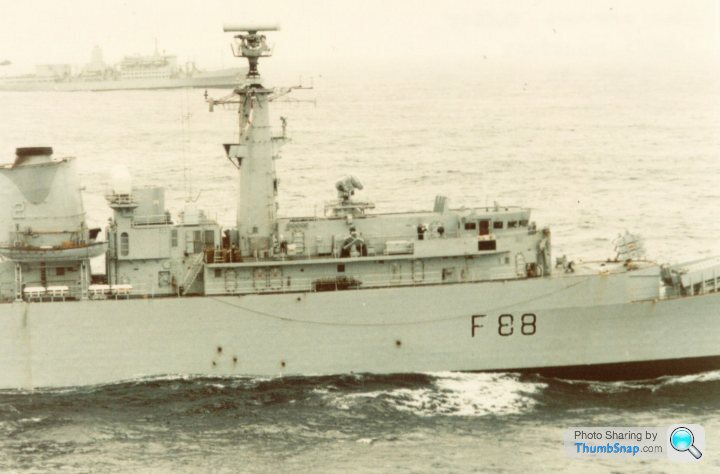
HMS Broadsword showing damage from canon fire.
Antrim was no longer capable of co-ordinating the air defence, and Brilliant took over.
The following radio exchange was made:
Hermes: "Now you be very careful with our aircraft"
Brilliant: "Of course we'll be very careful. Don't worry. We know what we're bloody doing"
Brilliant attempts to direct two Sea Harriers onto the departing two Daggers, but they're too late to catch them.
Ardent blows up a Pucara on the runway at Goose Green with its gun, "Quite by accident" according to her captain. Antrim makes her way to Fearless and is boarded by bomb disposal experts.
13:45. Two more Pucaras arrive on the scene, but are driven off by gunfire and a Sea Cat from Ardent.
14:00 The Pucaras return, heading for Ardent, but Brilliant directs two Sea Harriers onto them. LtCdr Sharky Ward kills one with cannon fire, the pilot ejected and walked back to base. The other escaped.
15:00. Four A-4s arrive, and take a crack at Ardent as well. The bombs all missed, some bouncing over. The aircraft were so low that one hit the ship's radar arial with its belly tank. This wouldn't be the last 'plane-to-ship contact.
As they left, they were chased by two Sea Harriers, two are shot down by missiles.
Incidentally, the senior Naval officer aboard SS Canberra, Cpt Chris Burne, kept a running commentary on proceedings throughout the day on the ship's PA system interspersed with humour which earned him great respect.
16:00. Six A-4s arrive and make for Argonaut. Five made it through the barrage, and dropped ten bombs. Two hit, but neither exploded. (A pattern which was noted by many, including the BBC reporters who advertised this fact on the air. Shortly afterwards, Argentine bombs started exploding more reliably. This would not be the only point of grievance between the Forces and the BBC.)
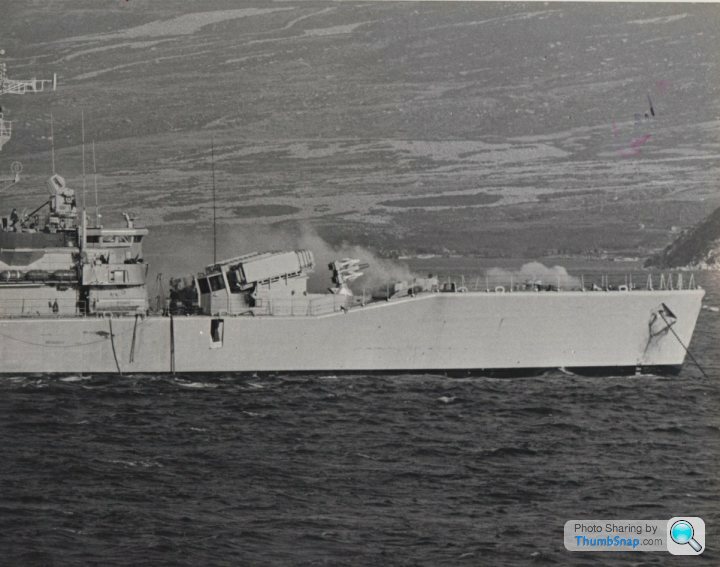
Bomb damage on HMS Argonaut
One bomb punched through the forward fuel tanks before coming to rest in the Sea Cat magazine, and starting a fire and killing two sailors.
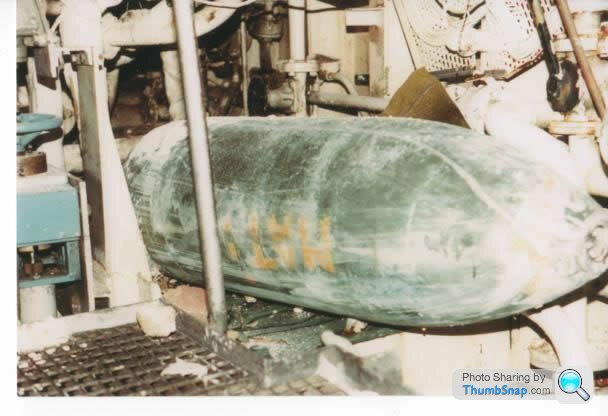
1000lb bomb resting in the SeaCat Magazine
Fuel from the bunkers leaked onto the fire, extinguishing it.
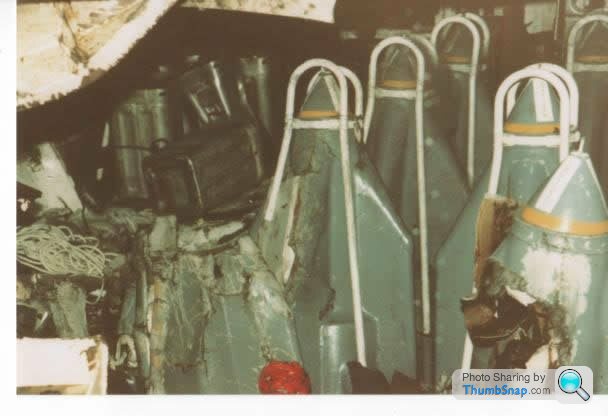
Bomb damage in SeaCat Magazine
The second bomb hit the engine room, wrecking the steering mechanism and reverse gearing.
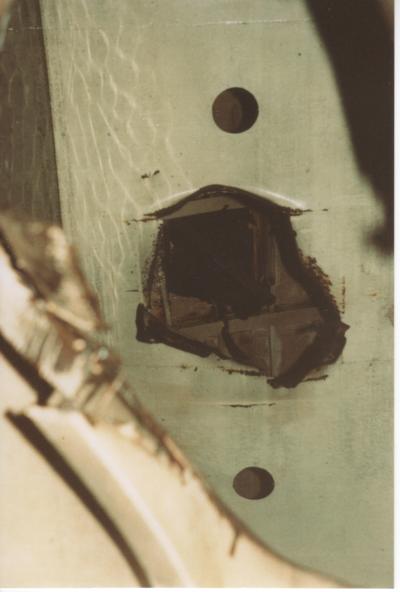
With effectively no brakes, and no steering, the ship was heading towards the rocks at Fanning Head, before a freshly minted Sub-Lieutenant raced off the bridge, grabbed a couple of ratings en route, and dropped the anchor. Shortly afterwards, the ship lost all power.
Four Daggers are next to arrive, but Brilliant directs the Sea Harriers on them, and only three make it to the ships. Intrepid and Plymouth both fire Sea Cats which miss, Fort Austin scores a hit with a machinegun and forces another to abort.
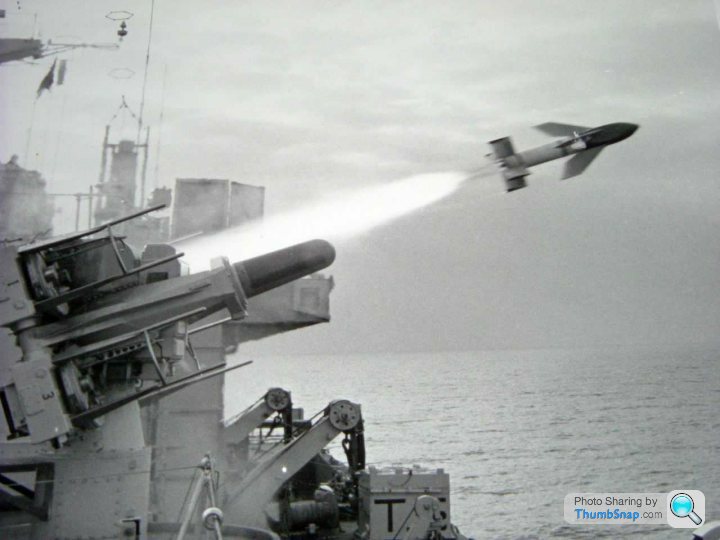
HMS Intrepid firing SeaCat
The remaining two make for Brilliant.
A Sea Wolf fires, but misses, perhaps causing sufficient distraction that the bombs miss. The 30mm cannon does not, and a shot goes right through the Ops room, a splinter entering the back of LtCdr Lee Hulme, who was directing the Sea Harriers. After a brief pause "Just a moment please", and discovering that he could still talk and think, he resumed his duties.
Three Navy Skyhawks came up Falkland Sound, drawing a bead on Ardent, which was sailing North after causing much nuisance with its 4.5" gun on the shore. The gun was out of arc, and the Sea Cat launcher refused to fire. This left just two 20mm cannons and anyone who could man a gun.
The ship's helicopter pilots, Sephton and Murphy, manned the flight deck with a Sterling Submachinegun and a Bren gun. The Navy pilots were some of the best Argentina had, and were good at hitting ships, also they were the only arm to use retarded bombs, which are designed to explode from a low-level release (unlike the air force's bombs). Of nine bombs dropped, two exploded in the hangar, the third penetrated to the auxilliary machine room without exploding. The two pilots and a third man were killed by the blast. The Sea Cat launcher was hurled from the deck and crashed down on top of the ship's supply officer.

A fire broke out in the aft spaces, and she started to flood.
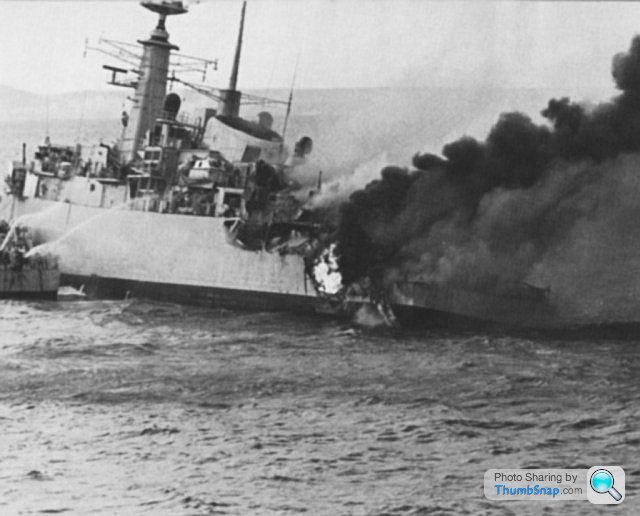
Ardent's doctor who watched the aircraft dodge land and defensive fire later remarked that "We should have figured out that any country which can produce such great Formula 1 drivers could produce good pilots..."
SD.
Two Pucara attack aircraft showed up about five minutes later. One was shot down by a hand-held Stinger missile from the SBS team on Fanning Head, the other was downed by a Sea Cat missile from a ship.

Shortly afterwards, a second Aermacchi turned up, and attacked HMS Argonaut with rockets and gunfire. Three sailors were injured, two seriously, and the big Type 965 radar suffered a large hole. The Aermacchi escaped through two missiles and a barrage of gunfire.
12:35 A formation of three Daggers arrives. Argonaut, Intrepid and Plymouth fire Sea Cats, Plymouth blows one Dagger up.
The second Dagger aims for HMS Broadsword, hitting with 29 30mm shells, but missing with both bombs. Fourteen sailors injured, and both helicopters damaged.
The third Dagger went for Antrim. A thousand-pounder struck the ship, went through the flight deck, bouncing off two big Sea Slug missiles in the magazine, and came to rest in the Head, starting a couple of fires. All the missile systems were knocked out.
12:41. Three more Daggers show up, and make for Antrim, whose crew are jettisoning missiles over the side in case the fires reached them. One got jettisonned by being fired in the general direction of the daggers, albeit unguided. Antrim was reduced to the twin guns in anti-air mode. One Dagger strafed with cannon, injuring seven more sailors and causing more fires. Second Dagger diverted to Fort Austin before being shot down by a Sea Wolf from Broadsword.

Bullet holes seen on HMS Antrim
The third Dagger now aimed for Broadsword, strafing her, but missing with the bomb.

Gun sight image from Argentinean Dagger during strafing run on HMS {i]broadsword[/i]

HMS Broadsword showing damage from canon fire.
Antrim was no longer capable of co-ordinating the air defence, and Brilliant took over.
The following radio exchange was made:
Hermes: "Now you be very careful with our aircraft"
Brilliant: "Of course we'll be very careful. Don't worry. We know what we're bloody doing"
Brilliant attempts to direct two Sea Harriers onto the departing two Daggers, but they're too late to catch them.
Ardent blows up a Pucara on the runway at Goose Green with its gun, "Quite by accident" according to her captain. Antrim makes her way to Fearless and is boarded by bomb disposal experts.
13:45. Two more Pucaras arrive on the scene, but are driven off by gunfire and a Sea Cat from Ardent.
14:00 The Pucaras return, heading for Ardent, but Brilliant directs two Sea Harriers onto them. LtCdr Sharky Ward kills one with cannon fire, the pilot ejected and walked back to base. The other escaped.
15:00. Four A-4s arrive, and take a crack at Ardent as well. The bombs all missed, some bouncing over. The aircraft were so low that one hit the ship's radar arial with its belly tank. This wouldn't be the last 'plane-to-ship contact.
As they left, they were chased by two Sea Harriers, two are shot down by missiles.
Incidentally, the senior Naval officer aboard SS Canberra, Cpt Chris Burne, kept a running commentary on proceedings throughout the day on the ship's PA system interspersed with humour which earned him great respect.
16:00. Six A-4s arrive and make for Argonaut. Five made it through the barrage, and dropped ten bombs. Two hit, but neither exploded. (A pattern which was noted by many, including the BBC reporters who advertised this fact on the air. Shortly afterwards, Argentine bombs started exploding more reliably. This would not be the only point of grievance between the Forces and the BBC.)

Bomb damage on HMS Argonaut
One bomb punched through the forward fuel tanks before coming to rest in the Sea Cat magazine, and starting a fire and killing two sailors.

1000lb bomb resting in the SeaCat Magazine
Fuel from the bunkers leaked onto the fire, extinguishing it.

Bomb damage in SeaCat Magazine
The second bomb hit the engine room, wrecking the steering mechanism and reverse gearing.

With effectively no brakes, and no steering, the ship was heading towards the rocks at Fanning Head, before a freshly minted Sub-Lieutenant raced off the bridge, grabbed a couple of ratings en route, and dropped the anchor. Shortly afterwards, the ship lost all power.
Four Daggers are next to arrive, but Brilliant directs the Sea Harriers on them, and only three make it to the ships. Intrepid and Plymouth both fire Sea Cats which miss, Fort Austin scores a hit with a machinegun and forces another to abort.

HMS Intrepid firing SeaCat
The remaining two make for Brilliant.
A Sea Wolf fires, but misses, perhaps causing sufficient distraction that the bombs miss. The 30mm cannon does not, and a shot goes right through the Ops room, a splinter entering the back of LtCdr Lee Hulme, who was directing the Sea Harriers. After a brief pause "Just a moment please", and discovering that he could still talk and think, he resumed his duties.
Three Navy Skyhawks came up Falkland Sound, drawing a bead on Ardent, which was sailing North after causing much nuisance with its 4.5" gun on the shore. The gun was out of arc, and the Sea Cat launcher refused to fire. This left just two 20mm cannons and anyone who could man a gun.
The ship's helicopter pilots, Sephton and Murphy, manned the flight deck with a Sterling Submachinegun and a Bren gun. The Navy pilots were some of the best Argentina had, and were good at hitting ships, also they were the only arm to use retarded bombs, which are designed to explode from a low-level release (unlike the air force's bombs). Of nine bombs dropped, two exploded in the hangar, the third penetrated to the auxilliary machine room without exploding. The two pilots and a third man were killed by the blast. The Sea Cat launcher was hurled from the deck and crashed down on top of the ship's supply officer.

A fire broke out in the aft spaces, and she started to flood.

Ardent's doctor who watched the aircraft dodge land and defensive fire later remarked that "We should have figured out that any country which can produce such great Formula 1 drivers could produce good pilots..."
SD.
Need a coffee now before more typing!
Great thread.
Surprised Maggie did not go n*clear. Just drop a couple on Buenos Aries and wrap it up in a few days. Perhaps there were no n*clear subs in the Southern Atlantic at the time.
Almost certainly Britain's last great hurrah of Empire. Armed forces are too small and economy too poor now to do it again
Surprised Maggie did not go n*clear. Just drop a couple on Buenos Aries and wrap it up in a few days. Perhaps there were no n*clear subs in the Southern Atlantic at the time.
Almost certainly Britain's last great hurrah of Empire. Armed forces are too small and economy too poor now to do it again

21st May Supplemental.
Yet another formation of three Daggers arrives, but are met by Harriers piloted by Sharkey Ward and Steve Thomas.
As the Harriers dive onto their targets, they are engaged by small arms fire from Port Howard, which shot down the GR3 earlier. Thomas receives three hits, but continues anyway. All three Daggers are shot down, and the Harriers both return to Invincible.
Still more Skyhawks arrive, and they fall in on Ardent, whose smoke is probably making it easy to find. Maintaining 'Every man with a gun', the ship's civilian NAAFI manager, John Leake, is manning a GPMG, and is credited with a hit on an A-4, whose pilot ejects. Seven bombs hit. Three Skyhawks are shot down by two Sea Harriers as they leave, two by gunfire, one by a missile. Ardent was now suffering 22 dead, 37 wounded, was on fire, and flooding. CDR West orders the ship be abandoned.
Video taken through the SeaWolf tracking camera on HMS Broadsword showing the fire on HMS Ardent
Commander Alan West interview.
HMS Yarmouth puts her stern alongside Ardent's bow, and the ship's remaining company of 142 officers and men simply step across. Cdr West is the last person to leave the ship.
Cdr West became First Sea Lord 2002 - 2006. He was awarded the DSO for his action.
Ardent continued to burn throughout the night, accompanied by the occasional explosion, until she sank the following morning, with only her foremast remaining above the water. Within days navy divers removed her light AA guns for fitting to other ships and her foremast was used as Navigational warning and datum by her sister ship Arrow whilst she bombarded Goose Green. The wreck site is designated as a controlled site under the Protection of Military Remains Act.
Read the Board of Inquiry report into the loss of HMS Ardent.
Five more Skyhawks arrive, but are driven away by fire from Antrim, Intrepid, Plymouth and Fearless. Nobody hits anything.
19:30. Survivors from Ardent cross-deck to Canberra.
Pymouth runs a power line to Argonaut so the latter has power. LtCdr Dutton manages to remove the un-exploded bomb from the missile magazine, making him the most junior officer to ever be awarded a DSO. Argonaut would be unable to steam for the rest of the week, and spend the time sitting in the middle of the bay shooting at anything which happened to fly into range.
Chief Petty Officer Fellows and his UXO team on Antrim cut out a 'tunnel' to lower the bomb into the water and get rid of it that way. He receives a DSC. Welding a four-foot square steel patch on the outside of the ship six feet from the bomb was CMEM Townsend.
Overall, for the loss of fifteen aircraft, the Argentinians had battered one ship to abandonment, two out of the fight for a while, and damage to two others.
On the other hand, there were no casualties to the landing force. To almost everyone's surprise Canberra was totally unscathed, it turned out the Argentine pilots had thought the massive white liner to be a hospital ship and deliberately didn't attack it. Some 4,000 troops were ashore.
Roll of Honour - HMS Ardent.
SD.
Yet another formation of three Daggers arrives, but are met by Harriers piloted by Sharkey Ward and Steve Thomas.
As the Harriers dive onto their targets, they are engaged by small arms fire from Port Howard, which shot down the GR3 earlier. Thomas receives three hits, but continues anyway. All three Daggers are shot down, and the Harriers both return to Invincible.
Still more Skyhawks arrive, and they fall in on Ardent, whose smoke is probably making it easy to find. Maintaining 'Every man with a gun', the ship's civilian NAAFI manager, John Leake, is manning a GPMG, and is credited with a hit on an A-4, whose pilot ejects. Seven bombs hit. Three Skyhawks are shot down by two Sea Harriers as they leave, two by gunfire, one by a missile. Ardent was now suffering 22 dead, 37 wounded, was on fire, and flooding. CDR West orders the ship be abandoned.
Video taken through the SeaWolf tracking camera on HMS Broadsword showing the fire on HMS Ardent
Commander Alan West interview.
HMS Yarmouth puts her stern alongside Ardent's bow, and the ship's remaining company of 142 officers and men simply step across. Cdr West is the last person to leave the ship.
Cdr West became First Sea Lord 2002 - 2006. He was awarded the DSO for his action.
Ardent continued to burn throughout the night, accompanied by the occasional explosion, until she sank the following morning, with only her foremast remaining above the water. Within days navy divers removed her light AA guns for fitting to other ships and her foremast was used as Navigational warning and datum by her sister ship Arrow whilst she bombarded Goose Green. The wreck site is designated as a controlled site under the Protection of Military Remains Act.
Read the Board of Inquiry report into the loss of HMS Ardent.
Five more Skyhawks arrive, but are driven away by fire from Antrim, Intrepid, Plymouth and Fearless. Nobody hits anything.
19:30. Survivors from Ardent cross-deck to Canberra.
Pymouth runs a power line to Argonaut so the latter has power. LtCdr Dutton manages to remove the un-exploded bomb from the missile magazine, making him the most junior officer to ever be awarded a DSO. Argonaut would be unable to steam for the rest of the week, and spend the time sitting in the middle of the bay shooting at anything which happened to fly into range.
Chief Petty Officer Fellows and his UXO team on Antrim cut out a 'tunnel' to lower the bomb into the water and get rid of it that way. He receives a DSC. Welding a four-foot square steel patch on the outside of the ship six feet from the bomb was CMEM Townsend.
Overall, for the loss of fifteen aircraft, the Argentinians had battered one ship to abandonment, two out of the fight for a while, and damage to two others.
On the other hand, there were no casualties to the landing force. To almost everyone's surprise Canberra was totally unscathed, it turned out the Argentine pilots had thought the massive white liner to be a hospital ship and deliberately didn't attack it. Some 4,000 troops were ashore.
Roll of Honour - HMS Ardent.
- Able Seaman Derek D. Armstrong
- Lieutenant Commander Richard W. Banfield
- Able Seaman Andrew R. Barr
- Petty Officer Peter Brouard
- Cook Richard S. J. Dunkerley
- Leading Cook Michael P. Foote
- Marine Engineering Mechanic Stephen H. Ford
- Acting Steward Shaun Hanson
- Able Seaman Shaun K. Hayward
- Able Seaman Stephen Heyes
- Weapons Engineering Mechanic Simon J. Lawson
- Marine Engineering Mechanic Alistair R. Leighton
- Air Engineering Mechanician Allan McAuley
- Acting Leading Seaman Michael S. Mullen
- Lieutenant Brian Murphy
- Leading Physical Training Instructor Gary T. Nelson
- Cook John R. Roberts
- Lieutenant Commander John M. Sephton
- Leading Marine Engineering Mechanic Stephen J. White
- Leading Marine Engineering Mechanic Garry Whitford
- Petty Officer Weapons Engineering Mechanician Andrew K. Palmer
- Marine Engineering Mechanic Gilbert S. Williams
SD.
Edited by shed driver on Sunday 21st May 20:46
Gassing Station | The Lounge | Top of Page | What's New | My Stuff




 t I did not know it was so difficult, and that it was actually a success. I thought the runway was repaired within 24 hours.
t I did not know it was so difficult, and that it was actually a success. I thought the runway was repaired within 24 hours.